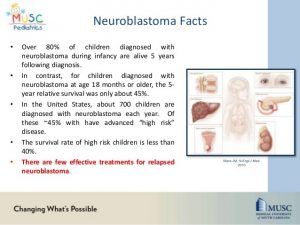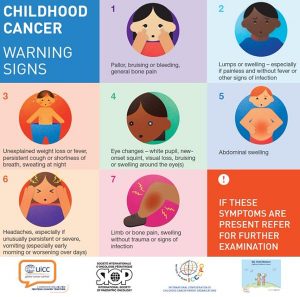Key Statistics for Childhood Cancers
Childhood cancers make up less than 1% of all cancers diagnosed each year. About 10,470 children in the United States under the age of 15 will be diagnosed with cancer in 2022. Childhood cancer rates have been rising slightly for the past few decades.
Because of major treatment advances in recent decades, more than 85% of children with cancer now survive 5 years or more. Overall, this is a huge increase since the mid-1970s, when the 5-year survival rate was about 58%. Still, survival rates vary depending on the type of cancer and other factors. The survival rates for a specific type of childhood cancer can be found in our information for that cancer type.
After accidents, cancer is the second leading cause of death in children ages 1 to 14 . About 1,050 children younger than 15 years old are expected to die from cancer in 2022.
Cancers that Develop in Children

The types of cancers that occur most often in children are different from those seen in adults. The most common cancers of children are:
- Leukemia
- Brain and spinal cord tumors
- Neuroblastoma
- Wilms tumor
- Lymphoma (including both Hodgkin and non-Hodgkin)
- Rhabdomyosarcoma
- Retinoblastoma
- Bone cancer (including osteosarcoma and Ewing sarcoma)
Other types of cancers are rare in children, but they do happen sometimes. In very rare cases, children may even develop cancers that are much more common in adults.
Screening for cancer in children
Screening is testing for a disease such as cancer in people who don’t have any symptoms. Childhood cancers are rare, and there are no widely recommended screening tests to look for cancer in children who are not at increased risk.
Some children have a higher chance of developing a specific type of cancer because of certain gene changes they inherit from a parent. These children may need careful, regular medical check-ups that include special tests to look for early signs of cancer.
Possible signs and symptoms of cancer in children

Many cancers in children are found early, either by a child’s doctor or by parents or relatives. But cancers in children can be hard to recognize right away because early symptoms are often like those caused by much more common illnesses or injuries. Children often get sick or have bumps or bruises that might mask the early signs of cancer. Cancer in children is not common, but it’s important to have your child checked by a doctor if they have unusual signs or symptoms that do not go away, such as:
- An unusual lump or swelling
- Unexplained paleness and loss of energy
- Easy bruising
- An ongoing pain in one area of the body
- Limping
- Unexplained fever or illness that doesn’t go away
- Frequent headaches, often with vomiting
- Sudden eye or vision changes
- Sudden unexplained weight loss
Most of these symptoms are much more likely to be caused by something other than cancer, such as an injury or infection. Still, if your child has any of these symptoms, see a doctor so that the cause can be found and treated, if needed.
Reference:
https://www.cancer.org/cancer/cancer-in-children
